
Tunis is the capital and largest city of Tunisia. The greater metropolitan area of Tunis, often referred to as "Grand Tunis", has about 2,700,000 inhabitants. As of 2020, it is the third-largest city in the Maghreb region and the eleventh-largest in the Arab world.

A mausoleum is an external free-standing building constructed as a monument enclosing the interment space or burial chamber of a deceased person or people. A mausoleum without the person's remains is called a cenotaph. A mausoleum may be considered a type of tomb, or the tomb may be considered to be within the mausoleum.
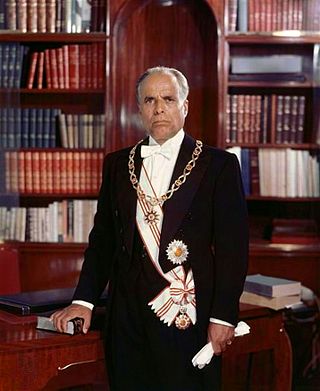
Habib Bourguiba was a Tunisian lawyer, nationalist leader and statesman who led the country from 1956 to 1957 as the prime minister of the Kingdom of Tunisia (1956–1957) then as the first president of Tunisia (1957–1987). Prior to his presidency, he led the nation to independence from France, ending the 75-year-old protectorate and earning the title of "Supreme Combatant".

The Tunisian Sahel or more precisely the Central East Tunisia Region is an area of central eastern Tunisia and one of the six Tunisian regions. It stretches along the eastern shore, from Hammamet in the north to Mahdia in the south, including the governorates of Monastir, Mahdia and Sousse. Its name derives from the Arabic word sāḥil (ساحل), meaning "shore" or "coast". The region's economy is based especially on tourism and it contains the second-biggest airport in Tunisia: Monastir Habib Bourguiba International Airport.

Monastir, also called Mestir, is a city on the central coast of Tunisia, in the Sahel area, some 20 kilometres south of Sousse and 162 kilometres south of Tunis. Traditionally a fishing port, Monastir is now a major tourist resort. Its population is about 93,306. It is the capital of Monastir Governorate.
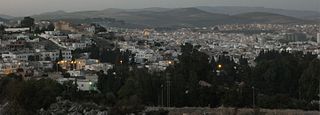
Béja is a city in Tunisia. It is the capital of the Béja Governorate. It is located 105 kilometers (65 mi) from Tunis, between the Medjerdah River and the Mediterranean, against the foothills of the Khroumire, the town of Béja is situated on the sides of Djebel Acheb, facing the greening meadows, its white terraces and red roofs dominated by the imposing ruins of the old Roman fortress.

Sfax is a city in Tunisia, located 270 km (170 mi) southeast of Tunis. The city, founded in AD 849 on the ruins of Berber Taparura, is the capital of the Sfax Governorate, and a Mediterranean port. Sfax has a population of 330,440. The main industries are phosphate, olive and nut processing, fishing and international trade. The city is the second-most populous after the capital, Tunis.
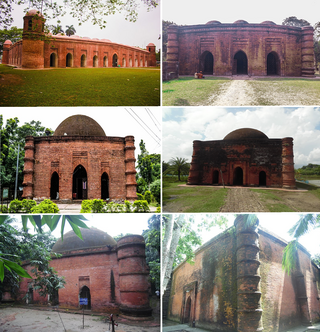
The Mosque City of Bagerhat is a UNESCO World Heritage Site in Bagerhat District, Bangladesh. It contains 360 mosques, public buildings, mausoleums, bridges, roads, water tanks and other public buildings constructed from baked brick. The mosques were built during the Bengal Sultanate in the 15th century, of which the Sixty Dome Mosque is the largest. Other mosques include the Singar Mosque, the Nine Dome Mosque, the Tomb of Khan Jahan, the Bibi Begni Mosque and the Ronvijoypur Mosque. The mosques were built during the governorship of Ulugh Khan Jahan, a Turkic military officer appointed as governor in the Sundarbans by Sultan Mahmud Shah of Bengal.
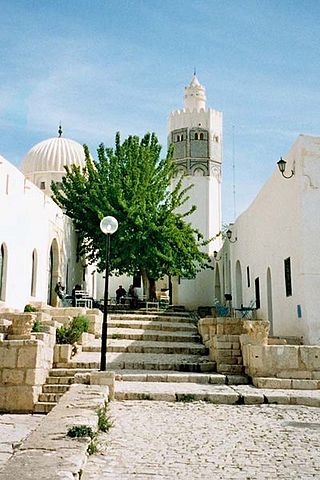
El Kef, also known as Le Kef, is a city in northwestern Tunisia. It serves as the capital of the Kef Governorate.

The mausoleum of Ruhollah Khomeini houses the tombs of Ayatollah Ruhollah Khomeini, his wife Khadijeh Saqafi, and his second son Ahmad Khomeini; and some political figures, such as former President Akbar Hashemi Rafsanjani, former Vice President Hassan Habibi, Lieutenant General Ali Sayad Shirazi, Iranian Revolution figure Sadeq Tabatabaei, and MP Marzieh Hadidchi. The mausoleum is located to the south of Tehran in the Behesht-e Zahra cemetery. Construction commenced in 1989 following Khomeini's death on June 3 of that year. It is still under construction, but when completed will be the centerpiece in a complex spread over 20 square kilometres, housing a cultural and tourist center, a university for Islamic studies, a seminary, a shopping mall, and a 20,000-car parking lot. The Iranian government has reportedly devoted 2 billion US dollars to this development.
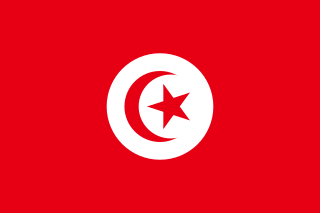
The Kingdom of Tunisia was a short-lived country established as a monarchy on 20 March 1956 after Tunisian independence and the end of the French protectorate period. It appeared for a period of one year and five months between 20 March 1956, the day of the independence, until 25 July 1957, the day of the declaration of the republic. Bey of Tunis, Muhammad VIII al-Amin with his Prime Minister, Habib Bourguiba.

The funerary complex of Sultan Qaytbay is an architectural complex built by Sultan al-Ashraf Qaytbay in Cairo's Northern Cemetery, completed in 1474. It is often considered one of the most beautiful and accomplished monuments of late Egyptian Mamluk architecture, and is pictured on the Egyptian one pound note.

Wassila Ben Ammar Bourguiba was the second wife of the former Tunisian president Habib Bourguiba and the First Lady of Tunisia from 1962 until 1986. She was called Majda (venerable).
The 1987 Tunisian coup d'état involved the bloodless ousting of the aging President of Tunisia Habib Bourguiba on 7 November 1987, and his replacement as President by his recently appointed Prime Minister, Zine El Abidine Ben Ali. The action was justified by reference to Bourguiba's failing health and Article 57 of the country's constitution. Reports later surfaced to indicate that the Italian intelligence services had been involved in planning it.

The Hanafi Mosque of Bourguiba is a Tunisian Hanafi mosque located in Monastir and dedicated to the first president of Tunisia, Habib Bourguiba.

The Tourbet el Bey is a Tunisian royal mausoleum in the southwest of the medina of Tunis.

The architecture of Algeria encompasses a diverse history influenced by a number of internal and external forces, including the Roman Empire, Muslim conquest of the Maghreb, French colonization, and movements for Algerian independence.

The Great Palaces of the Fatimid Caliphs were a vast and lavish palace complex built in the late 10th century in Cairo, Egypt, to house the Fatimid caliphs, their households, and the administration of their state. There were two main palace complexes, the Eastern and the Western Palace. They were located in the center of the walled city of Cairo around the area still known today as Bayn al-Qasrayn.

Bab Ftouh is the main southeastern gate of Fes el-Bali, the old walled city of Fes, Morocco.

The Kasbah of Moulay Ismail is a vast palace complex and royal kasbah (citadel) built by the Moroccan sultan Moulay Isma'il ibn Sharif in Meknes, Morocco. It is also known, among other names, as the Imperial City or Palaceof Moulay Ismail, or the Kasbah of Meknes. It was built by Moulay Isma'il over the many decades of his reign between 1672 and 1727, when he made Meknes the capital of Morocco, and received occasional additions under later sultans.


























